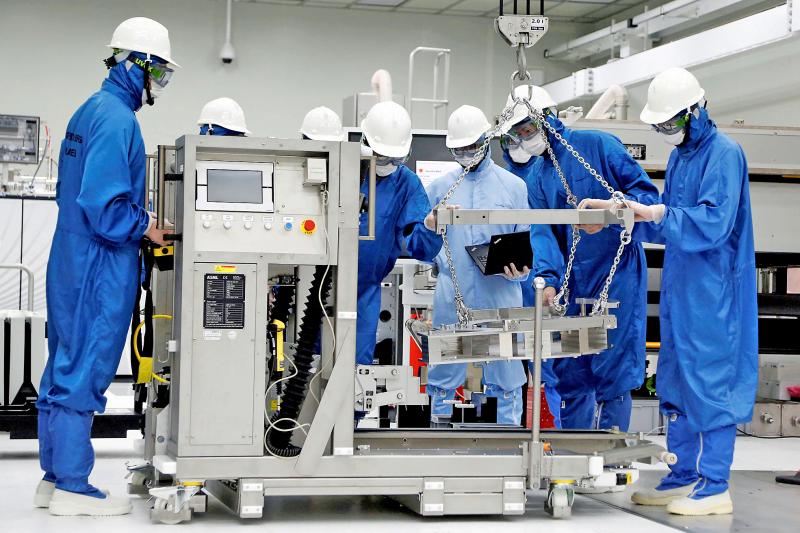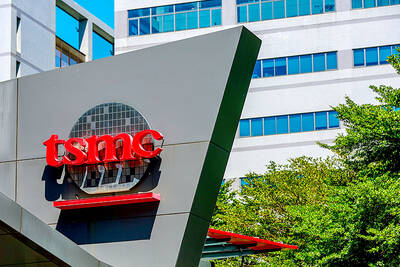Intel Corp yesterday said it has placed its first order with ASML Holding NV to purchase the semiconductor industry’s first TWINSCAN EXE: 5200 system, as the US chip giant aims to compete with Taiwan Semiconductor Manufacturing Co (TSMC, 台積電) in advancing to 2-nanometer process technology.
The Dutch semiconductor equipment maker’s TWINSCAN EXE:5200 system is an extreme ultraviolet (EUV) high-volume production system with a high numerical aperture (NA) that can produce 220 wafers per hour, more than the 150 wafers that its previous generation TWINSCAN EXE:5000 system can handle.
ASML aims to launch the new system in 2024.

Photo: Reuters
ASML president and chief technology officer Martin van den Brink said in a statement that the new system “delivers continued lithographic improvements at reduced complexity, cost, cycle time and energy that the chip industry needs to drive affordable scaling well into the next decade.”
Announcing the deal in a statement, Intel executive vice president and general manager of technology development Ann Kelleher said: “Working closely with ASML, we will harness high-NA EUV’s high-resolution patterning as one of the ways we continue Moore’s Law and maintain our strong history of progression down to the smallest of geometries.”
Intel was the first to purchase the TWINSCAN EXE:5000 system in 2018.
The company said that the new purchase reflects its continued collaboration with ASML and marks the beginning of its production with the new technology in 2025.
TSMC is also likely to buy the TWINSCAN EXE:5200 system and is expected to be the first in the industry to introduce 2-nanometer production, a supply chain source told the Taipei Times yesterday.
“Placing the first order does not mean Intel will be the first to massively produce chips with the tool,” the source said, adding that Intel still has a long way to go before catching up with TSMC in commercializing 2-nanometer technology.
TSMC’s 2-nanometer chips would enter the market in 2025, the firm said, adding that the chips would be the highest-performing chips available.
Separately, ASML yesterday said that it did not expect a factory fire in Germany to disrupt output.
The fire at its Berlin facility early this month was extinguished within two hours, and the company still expects to ship about 55 EUV systems this year, it said.
“We were able to put the fire out in a couple of hours, but still there was significant damage,” ASML chief executive officer Peter Wennink said in a statement. “Because of the hard work and the creativity, we currently believe that we can manage the situation and that we will not see a significant impact on our EUV output in the year 2022.”
Wennink said demand is 40 to 50 percent above the ASML’s maximum capacity, and it would take “two to three years to get a nice balance between supply and demand.”
The firm’s shipments would increase next year, he added.
Additional reporting by Bloomberg

RUN IT BACK: A succesful first project working with hyperscalers to design chips encouraged MediaTek to start a second project, aiming to hit stride in 2028 MediaTek Inc (聯發科), the world’s biggest smartphone chip supplier, yesterday said it is engaging a second hyperscaler to help design artificial intelligence (AI) accelerators used in data centers following a similar project expected to generate revenue streams soon. The first AI accelerator project is to bring in US$1 billion revenue next year and several billion US dollars more in 2027, MediaTek chief executive officer Rick Tsai (蔡力行) told a virtual investor conference yesterday. The second AI accelerator project is expected to contribute to revenue beginning in 2028, Tsai said. MediaTek yesterday raised its revenue forecast for the global AI accelerator used

Taiwan Semiconductor Manufacturing Co (TSMC, 台積電) has secured three construction permits for its plan to build a state-of-the-art A14 wafer fab in Taichung, and is likely to start construction soon, the Central Taiwan Science Park Bureau said yesterday. Speaking with CNA, Wang Chun-chieh (王俊傑), deputy director general of the science park bureau, said the world’s largest contract chipmaker has received three construction permits — one to build a fab to roll out sophisticated chips, another to build a central utility plant to provide water and electricity for the facility and the other to build three office buildings. With the three permits, TSMC

The DBS Foundation yesterday announced the launch of two flagship programs, “Silver Motion” and “Happier Caregiver, Healthier Seniors,” in partnership with CCILU Ltd, Hondao Senior Citizens’ Welfare Foundation and the Garden of Hope Foundation to help Taiwan face the challenges of a rapidly aging population. The foundation said it would invest S$4.91 million (US$3.8 million) over three years to foster inclusion and resilience in an aging society. “Aging may bring challenges, but it also brings opportunities. With many Asian markets rapidly becoming super-aged, the DBS Foundation is working with a regional ecosystem of like-minded partners across the private, public and people sectors

TEMPORARY TRUCE: China has made concessions to ease rare earth trade controls, among others, while Washington holds fire on a 100% tariff on all Chinese goods China is effectively suspending implementation of additional export controls on rare earth metals and terminating investigations targeting US companies in the semiconductor supply chain, the White House announced. The White House on Saturday issued a fact sheet outlining some details of the trade pact agreed to earlier in the week by US President Donald Trump and Chinese President Xi Jinping (習近平) that aimed to ease tensions between the world’s two largest economies. Under the deal, China is to issue general licenses valid for exports of rare earths, gallium, germanium, antimony and graphite “for the benefit of US end users and their suppliers